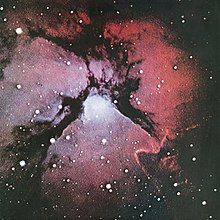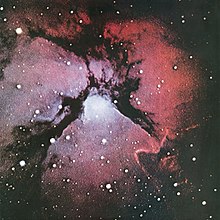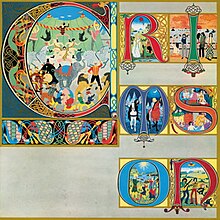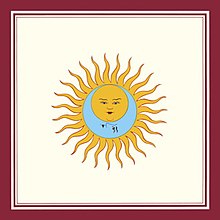
Rock and roll music

1971 studio album by King Crimson
Islands is the fourth studio album by English band King Crimson, released in 3 December 1971 on the record label Island.[6] Islands is the only studio album to feature the 1971–1972 touring line-up of Robert Fripp, Mel Collins, Boz Burrell and Ian Wallace. This would be the last album before an entirely new group (except for Fripp) would record the trilogy of Larks` Tongues in Aspic, Starless and Bible Black and Red between 1973 and 1974. This is also the last album to feature the lyrics of co-founding member Peter Sinfield.
Leer másIslands
King Crimson
Label: Island Atlantic · Studios: Command, London · Productor: King Crimson
CHARTS
UK
AUS
CAN
GER
ITA
US
|
1
|
Formentera Lady
King Crimson •
w: Robert Fripp (music) and Peter Sinfield (lyrics) •
1971 /12 /03 Side A
|
10:18 |
|
|
|
2
|
Sailor`s Tale (instrumental)
King Crimson •
w: Fripp •
1971 /12 /03 Side A
|
7:29 |
|
|
|
3
|
The Letters
King Crimson •
w: Robert Fripp (music) and Peter Sinfield (lyrics) •
1971 /12 /03 Side A
|
4:28 |
|
|
|
1
|
Ladies of the Road
King Crimson •
w: Robert Fripp (music) and Peter Sinfield (lyrics) •
1971 /12 /03 Side B
|
5:31 |
|
|
|
2
|
Prelude: Song of the Gulls (instrumental)
King Crimson •
w: Fripp •
1971 /12 /03 Side B
|
4:14 |
|
|
|
3
|
Islands (includes minute of silence and hidden track)
King Crimson •
w: Robert Fripp (music) and Peter Sinfield (lyrics) •
1971 /12 /03 Side B
|
11:51 |
|
Singles
No singles available
| Islands | ||||
|---|---|---|---|---|
 | ||||
| Studio album by | ||||
| Released | 3 December 1971[1] | |||
| Recorded | 22 July–3 October 1971 | |||
| Studio | Command, London | |||
| Genre | ||||
| Length | 43:49 | |||
| Label | ||||
| Producer | King Crimson | |||
| King Crimson chronology | ||||
| ||||
| King Crimson studio chronology | ||||
| ||||
| Peter Sinfield chronology | ||||
| ||||
Review
1971 studio album by King Crimson
Islands is the fourth studio album by English band King Crimson, released in 3 December 1971 on the record label Island.[6] Islands is the only studio album to feature the 1971–1972 touring line-up of Robert Fripp, Mel Collins, Boz Burrell and Ian Wallace. This would be the last album before an entirely new group (except for Fripp) would record the trilogy of Larks` Tongues in Aspic, Starless and Bible Black and Red between 1973 and 1974. This is also the last album to feature the lyrics of co-founding member Peter Sinfield.
Leer másMusically, the album expands on the improvisational jazz leanings of King Crimson`s previous album, Lizard. It received a mixed response from critics and fans.
Content
The harmonic basis for the tune "The Letters" is derived from the Giles, Giles and Fripp song "Why Don`t You Just Drop In", available on The Brondesbury Tapes compilation.[7] The bridge section is also taken from the King Crimson version of the song, performed by the original line-up, titled simply "Drop In" and later released on the live-album Epitaph.
The lyrics to "Ladies of the Road" are a series of male sexual fantasies revolving around "girls of the road", i.e. groupies. Lyricist Peter Sinfield later commented on the song: "... everybody writes at least one groupie song. We shouldn`t. But we do. It is the ultimate sexist lyric of all time. I couldn`t imagine anyone taking it too seriously, because in those days you were still able to say things like `my lady` with a capital M and a capital L." [emphasis in original][8]
The original basis for the song "Prelude: Song of the Gulls" is derived from the Giles, Giles and Fripp song "Suite No. 1".[7]
The first vinyl release of the album features a hidden track. At the end of side two there is a recording of studio chatter followed by Robert Fripp saying, among other things, "...What we`re going to do, umm... do it twice more, once with the oboe, once without it, and then... we finish." This was included on the initial CD release but was accidentally left off the first pressings of the 1989 Definitive Edition CD remaster. It was restored on all subsequent reissues, and has been used as "walk on" music for all shows starting in 2014.
Sinfield was fired by Fripp following Islands, after what the latter musician viewed as a year and a half of increasing hostility. While Sinfield believed creative tensions were essential for the creativity of the band, he has since opined that his suggestions on the band`s future being so unlike Fripp`s sowed the seeds of the discontent, saying: "I think the famous `big` problems really occurred leading up to Islands, where I musically wanted to find a softer, Miles Davis-with-vocals sexy package."[9] Over time, Sinfield has been quoted as referring to the album as "my Islands", an assertion denied by Fripp who has said: "I`m not sure why Peter Sinfield would consider Islands to be his album, although it became clear at the time that Peter was increasingly using KC as a vehicle for his personal ambitions, rather than a joint/group undertaking. [...] But realistically, how was Islands Peter`s album? Peter didn`t compose or play music."[9]
Album cover
The original United Kingdom and European cover depicts the Trifid Nebula in Sagittarius and displays neither the name of the band nor the title. The original United States and Canadian album cover (as released by Atlantic) was a Peter Sinfield painting of off-white with coloured "islands". This was used as an internal gatefold sleeve in the UK. When the King Crimson catalogue was re-issued by EG, they standardised on the "Trifid Nebula" cover worldwide.
Release
Released on 3 December 1971, Islands reached number 30 in the UK Albums Chart.[10]
The album was re-released in 2010 as the fifth release in King Crimson`s 40th Anniversary series, featuring new stereo and 5.1 surround mixes by Steven Wilson and Robert Fripp, Sid Smith sleeve notes and extra tracks and alternative versions. The DVD-A presents a 5.1 surround sound mix by Wilson, a hi-res stereo version of the 2010 mix, a hi-res stereo version of the original album mix taken from the 30th anniversary master source and previously unreleased material, including studio takes mixed from the original recording sessions.[11][12]
Reception
| Review scores | |
|---|---|
| Source | Rating |
| All About Jazz | [13] |
| AllMusic | [7] |
| Christgau`s Record Guide | C[14] |
| Encyclopedia of Popular Music | [15] |
| The Great Rock Discography | 7/10[16] |
| Mojo | [17] |
| MusicHound | [18] |
| Rolling Stone | mixed[19] |
| The Rolling Stone Album Guide | [20] |
| Sputnikmusic | [21] |
Retrospective reviews have been mixed, with critics generally praising the band`s performances while finding the compositions and album structure aimless. AllMusic called it "the weakest Crimson studio album from their first era" that "is only a real disappointment in relation to the extraordinarily high quality of the group`s earlier efforts."[7] Conversely, All About Jazz described the album as a "well-conceived, tremendously executed and perfectly sequenced collection", and complimented Fripp`s use of "a more sophisticated jazz vernacular" in a rock context.[13]
In The Rough Guide to Rock (2003), Chris Dinsdale wrote that, despite being "a little directionless", Islands advances the jazz-rock fusion that King Crimson last explored on side two of Lizard (1970), and comments that "Sailor`s Tale" is a "masterful instrumental" that ranks among Fripp`s finest moments.[5] In Christgau`s Record Guide (1981), however, Robert Christgau criticised the album and quipped: "When I feel the need for contemporary chamber music or sexist japes, jazz libre or vers ordinaire, I`ll go to the source(s)."[14] A contributor to The New Rolling Stone Album Guide (2004) writes that the songs on Islands rank among King Crimson`s most pretentious, with the exception of "Ladies of the Road", which "sets its groupie-adoration lyric to a lean, edgy blues."[20]
According to authors Paul Hegarty and Martin Halliwell, Islands is "very much dominated by a stately mood development", especially on "Formentera Lady" and the title track, a development of the Miles Davis-style use of tone first found on "Bolero – The Peacock`s Tale" from Lizard. In particular, "Formentera Lady" is described by writer Sid Smith as being reminiscent of the "modal explorations of Miles Davis` `Shhh/Peaceful` on In a Silent Way."[22] In his book A New Day Yesterday: UK Progressive Rock & the 70s (2020), Mike Barnes describes Islands as "another oddity, encompassing sleazy R&B, pastoralia and pseudo-baroque", and deems it "generally more direct than Lizards", despite expansive moments like "Formentera Lady".[23] Martin C. Strong pinpoints Islands as the third in a four album run from 1970 to 1973 in which King Crimson moved into avant-jazz territory.[16]
Track listing
All songs written by Robert Fripp (Music) and Peter Sinfield (lyrics).
| No. | Title | Writer(s) | Length |
|---|---|---|---|
| 1. | "Formentera Lady" | 10:18 | |
| 2. | "Sailor`s Tale" (instrumental) | Fripp | 7:29 |
| 3. | "The Letters" | 4:28 |
| No. | Title | Writer(s) | Length |
|---|---|---|---|
| 4. | "Ladies of the Road" | 5:31 | |
| 5. | "Prelude: Song of the Gulls" (instrumental) | Fripp | 4:14 |
| 6. | "Islands" (includes minute of silence and hidden track) | 11:51 |
Personnel
King Crimson
- Robert Fripp – guitar, mellotron, harmonium (6), production
- Peter Sinfield – lyrics, cover design and painting, production
- Mel Collins – saxophones, flute, bass flute (6), backing vocals, production
- Ian Wallace – drums, percussion, backing vocals, production
- Boz – bass, lead vocals, production
Additional personnel
- Paulina Lucas – soprano vocals (1)
- Keith Tippett – piano
- Robin Miller – oboe
- Mark Charig – cornet
- Harry Miller – double bass (1, 6 (orchestral tune-up only))
- Wilf Gibson – violin (1), string orchestra leader (5, 6 (orchestral tune-up only)) (uncredited)[24]
- Uncredited musicians – strings (2, 5, 6 (orchestral tune-up only))
- Andy Hendrikson – recording, engineering
- Tony Arnold – mastering
- Vick & Mike – equipment
- Robert Ellis – photography
2009 40th Anniversary Series re-issue personnel
- Steven Wilson – mixing, production, compilation and coordination input and suggestions
- Simon Heyworth (Super Audio Mastering) – stereo file preparation, 5.1 mastering
- Claire Bidwell (Opus Productions) – DVD design and layout
- Neil Wilkes (Opus Productions) – DVD authoring and assembly
- Jon Urban, Bob Romano, Bob Squires, Patrick Cleasby, Tim McDonnell & Chris Gerhard – DVD QC testing
- Kevin Vanbergen (FX Copyroom) – multitrack tape restoration and transfers
- Alex R. Mundy – DGM tape archiving
- Hugh O`Donnell – package art and design
- Declan Colgan (DGM) – compilation, coordination
- Sid Smith – liner notes, compilation and coordination input and suggestions
- John Kimber – US vinyl record sleeve scan
Charts
| Chart (1971–1972) | Peak position |
|---|---|
| Australian Albums (Kent Music Report)[25] | 49 |
| Canada Top Albums/CDs (RPM)[26] | 52 |
| Finnish Albums (The Official Finnish Charts)[27] | 21 |
| German Albums (Offizielle Top 100)[28] | 35 |
| Italian Albums (Musica e Dischi)[29] | 21 |
| Japanese Albums (Oricon)[30] | 61 |
| UK Albums (OCC)[31] | 30 |
| US Billboard 200[32] | 76 |
1971 studio album by King Crimson
Islands is the fourth studio album by English band King Crimson, released in 3 December 1971 on the record label Island.[6] Islands is the only studio album to feature the 1971–1972 touring line-up of Robert Fripp, Mel Collins, Boz Burrell and Ian Wallace. This would be the last album before an entirely new group (except for Fripp) would record the trilogy of Larks` Tongues in Aspic, Starless and Bible Black and Red between 1973 and 1974. This is also the last album to feature the lyrics of co-founding member Peter Sinfield.
Musically, the album expands on the improvisational jazz leanings of King Crimson`s previous album, Lizard. It received a mixed response from critics and fans.
Content
The harmonic basis for the tune "The Letters" is derived from the Giles, Giles and Fripp song "Why Don`t You Just Drop In", available on The Brondesbury Tapes compilation.[7] The bridge section is also taken from the King Crimson version of the song, performed by the original line-up, titled simply "Drop In" and later released on the live-album Epitaph.
The lyrics to "Ladies of the Road" are a series of male sexual fantasies revolving around "girls of the road", i.e. groupies. Lyricist Peter Sinfield later commented on the song: "... everybody writes at least one groupie song. We shouldn`t. But we do. It is the ultimate sexist lyric of all time. I couldn`t imagine anyone taking it too seriously, because in those days you were still able to say things like `my lady` with a capital M and a capital L." [emphasis in original][8]
The original basis for the song "Prelude: Song of the Gulls" is derived from the Giles, Giles and Fripp song "Suite No. 1".[7]
The first vinyl release of the album features a hidden track. At the end of side two there is a recording of studio chatter followed by Robert Fripp saying, among other things, "...What we`re going to do, umm... do it twice more, once with the oboe, once without it, and then... we finish." This was included on the initial CD release but was accidentally left off the first pressings of the 1989 Definitive Edition CD remaster. It was restored on all subsequent reissues, and has been used as "walk on" music for all shows starting in 2014.
Sinfield was fired by Fripp following Islands, after what the latter musician viewed as a year and a half of increasing hostility. While Sinfield believed creative tensions were essential for the creativity of the band, he has since opined that his suggestions on the band`s future being so unlike Fripp`s sowed the seeds of the discontent, saying: "I think the famous `big` problems really occurred leading up to Islands, where I musically wanted to find a softer, Miles Davis-with-vocals sexy package."[9] Over time, Sinfield has been quoted as referring to the album as "my Islands", an assertion denied by Fripp who has said: "I`m not sure why Peter Sinfield would consider Islands to be his album, although it became clear at the time that Peter was increasingly using KC as a vehicle for his personal ambitions, rather than a joint/group undertaking. [...] But realistically, how was Islands Peter`s album? Peter didn`t compose or play music."[9]
Album cover
The original United Kingdom and European cover depicts the Trifid Nebula in Sagittarius and displays neither the name of the band nor the title. The original United States and Canadian album cover (as released by Atlantic) was a Peter Sinfield painting of off-white with coloured "islands". This was used as an internal gatefold sleeve in the UK. When the King Crimson catalogue was re-issued by EG, they standardised on the "Trifid Nebula" cover worldwide.
Release
Released on 3 December 1971, Islands reached number 30 in the UK Albums Chart.[10]
The album was re-released in 2010 as the fifth release in King Crimson`s 40th Anniversary series, featuring new stereo and 5.1 surround mixes by Steven Wilson and Robert Fripp, Sid Smith sleeve notes and extra tracks and alternative versions. The DVD-A presents a 5.1 surround sound mix by Wilson, a hi-res stereo version of the 2010 mix, a hi-res stereo version of the original album mix taken from the 30th anniversary master source and previously unreleased material, including studio takes mixed from the original recording sessions.[11][12]
Reception
| Review scores | |
|---|---|
| Source | Rating |
| All About Jazz | [13] |
| AllMusic | [7] |
| Christgau`s Record Guide | C[14] |
| Encyclopedia of Popular Music | [15] |
| The Great Rock Discography | 7/10[16] |
| Mojo | [17] |
| MusicHound | [18] |
| Rolling Stone | mixed[19] |
| The Rolling Stone Album Guide | [20] |
| Sputnikmusic | [21] |
Retrospective reviews have been mixed, with critics generally praising the band`s performances while finding the compositions and album structure aimless. AllMusic called it "the weakest Crimson studio album from their first era" that "is only a real disappointment in relation to the extraordinarily high quality of the group`s earlier efforts."[7] Conversely, All About Jazz described the album as a "well-conceived, tremendously executed and perfectly sequenced collection", and complimented Fripp`s use of "a more sophisticated jazz vernacular" in a rock context.[13]
In The Rough Guide to Rock (2003), Chris Dinsdale wrote that, despite being "a little directionless", Islands advances the jazz-rock fusion that King Crimson last explored on side two of Lizard (1970), and comments that "Sailor`s Tale" is a "masterful instrumental" that ranks among Fripp`s finest moments.[5] In Christgau`s Record Guide (1981), however, Robert Christgau criticised the album and quipped: "When I feel the need for contemporary chamber music or sexist japes, jazz libre or vers ordinaire, I`ll go to the source(s)."[14] A contributor to The New Rolling Stone Album Guide (2004) writes that the songs on Islands rank among King Crimson`s most pretentious, with the exception of "Ladies of the Road", which "sets its groupie-adoration lyric to a lean, edgy blues."[20]
According to authors Paul Hegarty and Martin Halliwell, Islands is "very much dominated by a stately mood development", especially on "Formentera Lady" and the title track, a development of the Miles Davis-style use of tone first found on "Bolero – The Peacock`s Tale" from Lizard. In particular, "Formentera Lady" is described by writer Sid Smith as being reminiscent of the "modal explorations of Miles Davis` `Shhh/Peaceful` on In a Silent Way."[22] In his book A New Day Yesterday: UK Progressive Rock & the 70s (2020), Mike Barnes describes Islands as "another oddity, encompassing sleazy R&B, pastoralia and pseudo-baroque", and deems it "generally more direct than Lizards", despite expansive moments like "Formentera Lady".[23] Martin C. Strong pinpoints Islands as the third in a four album run from 1970 to 1973 in which King Crimson moved into avant-jazz territory.[16]
Track listing
All songs written by Robert Fripp (Music) and Peter Sinfield (lyrics).
| No. | Title | Writer(s) | Length |
|---|---|---|---|
| 1. | "Formentera Lady" | 10:18 | |
| 2. | "Sailor`s Tale" (instrumental) | Fripp | 7:29 |
| 3. | "The Letters" | 4:28 |
| No. | Title | Writer(s) | Length |
|---|---|---|---|
| 4. | "Ladies of the Road" | 5:31 | |
| 5. | "Prelude: Song of the Gulls" (instrumental) | Fripp | 4:14 |
| 6. | "Islands" (includes minute of silence and hidden track) | 11:51 |
Personnel
King Crimson
- Robert Fripp – guitar, mellotron, harmonium (6), production
- Peter Sinfield – lyrics, cover design and painting, production
- Mel Collins – saxophones, flute, bass flute (6), backing vocals, production
- Ian Wallace – drums, percussion, backing vocals, production
- Boz – bass, lead vocals, production
Additional personnel
- Paulina Lucas – soprano vocals (1)
- Keith Tippett – piano
- Robin Miller – oboe
- Mark Charig – cornet
- Harry Miller – double bass (1, 6 (orchestral tune-up only))
- Wilf Gibson – violin (1), string orchestra leader (5, 6 (orchestral tune-up only)) (uncredited)[24]
- Uncredited musicians – strings (2, 5, 6 (orchestral tune-up only))
- Andy Hendrikson – recording, engineering
- Tony Arnold – mastering
- Vick & Mike – equipment
- Robert Ellis – photography
2009 40th Anniversary Series re-issue personnel
- Steven Wilson – mixing, production, compilation and coordination input and suggestions
- Simon Heyworth (Super Audio Mastering) – stereo file preparation, 5.1 mastering
- Claire Bidwell (Opus Productions) – DVD design and layout
- Neil Wilkes (Opus Productions) – DVD authoring and assembly
- Jon Urban, Bob Romano, Bob Squires, Patrick Cleasby, Tim McDonnell & Chris Gerhard – DVD QC testing
- Kevin Vanbergen (FX Copyroom) – multitrack tape restoration and transfers
- Alex R. Mundy – DGM tape archiving
- Hugh O`Donnell – package art and design
- Declan Colgan (DGM) – compilation, coordination
- Sid Smith – liner notes, compilation and coordination input and suggestions
- John Kimber – US vinyl record sleeve scan
Charts
| Chart (1971–1972) | Peak position |
|---|---|
| Australian Albums (Kent Music Report)[25] | 49 |
| Canada Top Albums/CDs (RPM)[26] | 52 |
| Finnish Albums (The Official Finnish Charts)[27] | 21 |
| German Albums (Offizielle Top 100)[28] | 35 |
| Italian Albums (Musica e Dischi)[29] | 21 |
| Japanese Albums (Oricon)[30] | 61 |
| UK Albums (OCC)[31] | 30 |
| US Billboard 200[32] | 76 |
More Albums same artist
VIDEOS
See Video Album IslandsKing Crimson - Ladies Of The Road · Channel: King Crimson · 5m 35s


King Crimson - Formentera Lady · Channel: King Crimson · 10m 18s

King Crimson - Prelude: Song Of The Gulls · Channel: King Crimson · 4m 16s

King Crimson - Sailors Tale (OFFICIAL) · Channel: King Crimson · 7m 46s

Rizz Gone Wrong 😂 · Channel: Alan's Universe · 16s






